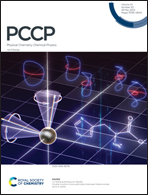Local and global aromaticity under rotation: analysis of two- and three-dimensional representative carbon nanostructures†
Abstract
Nanoscaled 2D and 3D carbon structures with closed curved π-surfaces are of relevance in the development of desirable building units for materials science. Such species are able to sustain local and global aromatic circuits involving isolated regions or the overall structural backbone, respectively. Here we account for local and global aromaticity under rotation of representative two- and three-dimensional species involving para-connected and fused edge-sharing phenyl rings ([8]CPP, [10]CPP, CNB), and C60 fullerene at different charge states. Our results denote that nanoscaled 2D global aromatics mimic the behaviour of the most prototypical aromatic 6π-circuit, given by benzene, where the shielding cone properties vary along the rotation motion. In contrast, 3D spherical aromatics remain almost invariant under rotation, given the distinctive characteristics of such species, differing from 2D global aromatics. Dissection of orbital contributions reveals that π-orbitals are determinants for shifting from non-aromatic to spherical aromatic species. Under rotation, the variation of the anisotropic effect inherent to such nanoscaled structures is accounted for, which is relevant to rationalize variation in NMR signal shifts upon the formation of host–guest aggregates.



 Please wait while we load your content...
Please wait while we load your content...